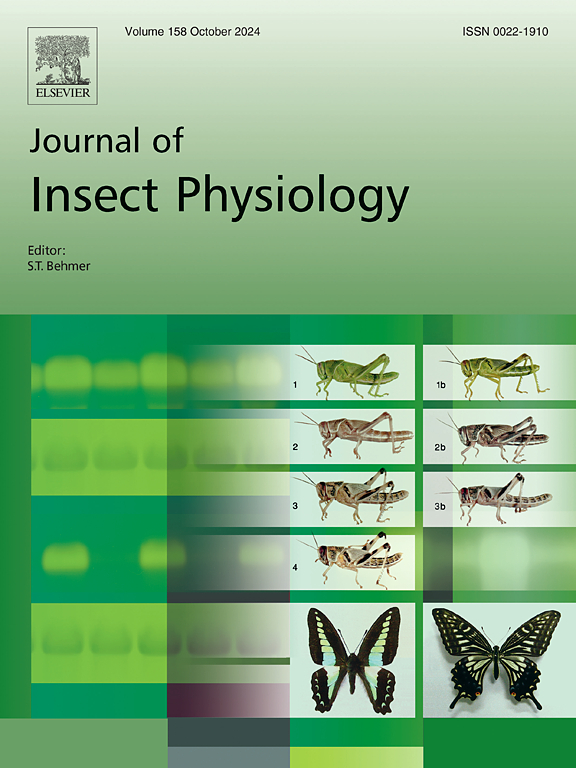野蜂能携带多少花蜜?研究蜜蜂营养和觅食生态的花蜜作物能力异速生长方程。
IF 2.3
2区 农林科学
Q1 ENTOMOLOGY
引用次数: 0
摘要
蜜蜂种群的减少受到自然栖息地丧失和气候变化导致的花卉资源(主要是花蜜和花粉)稀缺的影响。在这种情况下,了解野生蜜蜂的觅食成功和营养状况是至关重要的,特别是在对蜜蜂的研究已经超过了对野生物种的研究的情况下。本研究旨在建立野生蜜蜂采蜜能力的异速生长函数,为蜜蜂营养和觅食生态学研究提供预测工具。异速缩放模型通常将体型与形态或生态性状联系起来,被提出作为估计野生蜜蜂作物能力的方法。对法国南部25个不同属的2358只不同体型(体长5-29 mm)的自由放养觅食蜂进行了作物负荷测量。总的来说,我们建立了一致的异速生长函数来预测野生蜜蜂的体长对作物的负荷能力,具有令人满意的置信度。性别是作物产量的重要决定因素,雌性携带的最大花蜜量大约是同等大小雄性的三倍。我们还发现了分类亲缘关系影响作物产量异速性状的证据。然而,需要进一步的研究来完善分类群体的预测,特别是对社会性大黄蜂的预测。涉及花蜜可用性补充数据的实地验证表明,异速生长框架可用于解决与大型野生蜜蜂(体长与蜜蜂相似或大于蜜蜂)觅食成功和花蜜竞争相关的研究问题。未来的研究应该致力于将异速生长功能的分类分辨率提高到科或属的水平,这将有助于更好地理解某些蜜蜂群体的生态特性,例如,觅食者为整个群体储存花蜜的社会性物种,或者相反,不提供后代的寄生性(杜鹃)雌性蜜蜂。本文章由计算机程序翻译,如有差异,请以英文原文为准。

How much nectar can wild bees carry? Allometric equations of nectar crop capacities for investigating bee nutrition and foraging ecology
The decline in bee populations is influenced by the scarcity of floral resources, mainly nectar and pollen, resulting from the loss of natural habitats and climate change. In this context, it is essential to understand the foraging success and nutritional status of wild bees, particularly as research on honeybees has overshadowed that of wild species. This study aims to establish allometric functions for the nectar crop capacities of wild bees, which may be used as predictive tools in research related to bee nutrition and foraging ecology. Allometric scaling models, which typically relate body size to morphological or ecological traits, are proposed as a method of estimating crop capacity in wild bees. The crop load was measured in 2358 free-ranging foragers of different sizes (body length 5–29 mm) belonging to 25 different genera, in southern France. Overall, we established consistent allometric functions for predicting crop load capacities from the body length of wild bees, with a satisfactory degree of confidence. Sex is an important determinant of crop capacity, with females carrying maximal nectar loads around three times greater than males of similar size. We also found evidence that taxonomic affiliation influences allometric properties of crop capacities. Further studies are however needed to refine the predictions by taxonomic group, and in particular for the eusocial bumblebees. Field validation involving complementary data on floral nectar availability indicated that an allometric framework can be used to address research questions related to foraging success and competition for nectar in large wild bees (body length similar or greater than that of honeybees). Future studies should aim at refining the taxonomic resolution of allometric functions to family or genus level, which would provide a better understanding of the ecological particularities of certain groups of bees, such as eusocial species whose foragers store nectar for the entire colony or, conversely, cleptoparasitic (cuckoo) female bees that do not supply their broods.
求助全文
通过发布文献求助,成功后即可免费获取论文全文。
去求助
来源期刊

Journal of insect physiology
生物-昆虫学
CiteScore
4.50
自引率
4.50%
发文量
77
审稿时长
57 days
期刊介绍:
All aspects of insect physiology are published in this journal which will also accept papers on the physiology of other arthropods, if the referees consider the work to be of general interest. The coverage includes endocrinology (in relation to moulting, reproduction and metabolism), pheromones, neurobiology (cellular, integrative and developmental), physiological pharmacology, nutrition (food selection, digestion and absorption), homeostasis, excretion, reproduction and behaviour. Papers covering functional genomics and molecular approaches to physiological problems will also be included. Communications on structure and applied entomology can be published if the subject matter has an explicit bearing on the physiology of arthropods. Review articles and novel method papers are also welcomed.
 求助内容:
求助内容: 应助结果提醒方式:
应助结果提醒方式:


